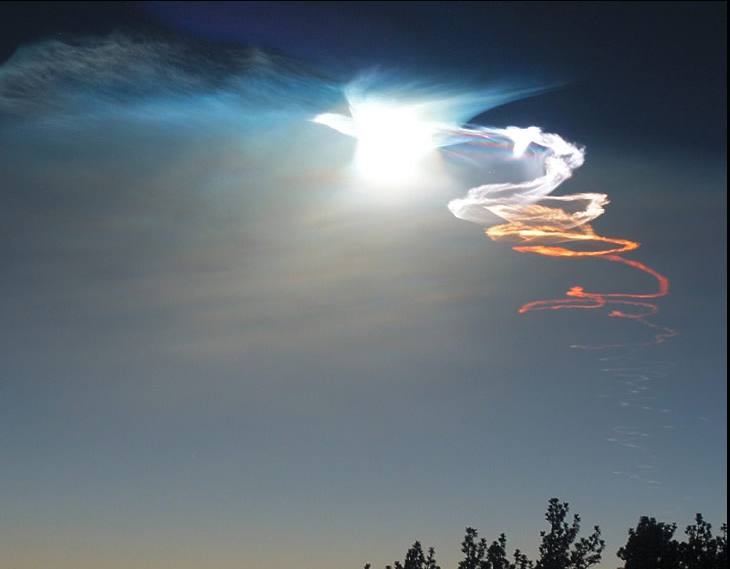The Dove - High Clouds II
The Dove - High Clouds II: Exploring the Phenomenon of Rocket Trails and Atmospheric Optics
Rocket trails, a captivating atmospheric phenomenon, often leave us in awe with their mesmerizing displays. One such remarkable example is captured in the image above, taken by James Young from JPL Table Mountain Observatory in California. The photograph showcases the exhaust trail left behind by a Vandenberg rocket, which has been intriguingly shaped by the winds, creating a twisted and contorted appearance.
The upper part of the rocket trail, aptly named "The Dove," emanates a brilliant glow as countless tiny particles or droplets scatter sunlight at high altitudes. These particles scatter the sunlight in various directions, resulting in the scattering phenomenon known as Rayleigh scattering. As a result, "The Dove" shines brightly against the backdrop of the sky. However, it is not just the upper part that captures our attention; the lower sections of the trail also contribute to the visual spectacle.
The lower parts of the rocket trail exhibit a captivating reddish glow, intensified by the passage of sunset rays through the lower atmosphere. As sunlight travels through Earth's atmosphere, it scatters more strongly at shorter wavelengths, such as blue and green, while longer wavelengths, like red and orange, are less affected. Consequently, when the sun is low on the horizon during sunset, its light passes through a greater thickness of the atmosphere. This causes more scattering of shorter wavelengths and allows predominantly red and orange light to reach our eyes, bathing the lower sections of the rocket trail in a deepening red hue.
One intriguing aspect of rocket trail phenomena is their propensity to produce intense iridescent colors. Iridescence occurs when light is diffracted or scattered by small particles or droplets, resulting in a spectrum of colors. In the case of rocket trails, the intense iridescence is primarily observed in the upper part, "The Dove." However, in the image mentioned earlier, faint banded colors are also visible, seemingly originating from the droplets present in intervening lower clouds. These droplets are illuminated from above by the bright trail, adding an additional layer of complexity and beauty to the overall scene.
To further delve into the topic of rocket trails and atmospheric optics, it is worth exploring additional aspects and considerations:
-
Rocket Trail Formation: Rocket trails are formed by the expulsion of exhaust gases during the launch of rockets. As the gases rapidly expand and mix with the surrounding atmosphere, they create a visible trail that can persist for varying lengths of time, depending on atmospheric conditions.
-
Composition of Rocket Trail Particles: The composition of particles present in rocket trails can vary, depending on the specific propellant used in the rocket. These particles can include water droplets, ice crystals, soot, and other byproducts of combustion.
-
Influence of Atmospheric Conditions: Atmospheric conditions, such as temperature, humidity, and wind patterns, play a crucial role in shaping the appearance of rocket trails. Winds can twist and contort the trail, as seen in the aforementioned image, creating visually stunning patterns.
-
Rocket Launch Viewing: Observing rocket launches and their resulting trails can be an awe-inspiring experience. The timing of the launch and atmospheric conditions greatly impact the visibility and appearance of the trail. Depending on factors such as sunlight angle and cloud cover, the trail may be more or less prominent.
-
Scientific Research Opportunities: Rocket trails provide scientists with a unique opportunity to study various atmospheric processes. By analyzing the scattering and diffraction patterns of light within these trails, researchers can gain insights into atmospheric composition, particle behavior, and optical phenomena.
-
Artistic and Aesthetic Value: Beyond their scientific significance, rocket trails also hold artistic and aesthetic value. The interplay of light, color, and atmospheric conditions creates captivating visual displays that inspire photographers, artists, and enthusiasts alike.
Rocket trails, with their captivating displays of light and color, offer a fascinating glimpse into the world of atmospheric optics. By understanding the underlying mechanisms behind these phenomena, we can appreciate the intricate beauty that surrounds us and further our knowledge of the natural world. So, the next time you witness a rocket trail painting the sky, take a moment to marvel at the intricate interplay of light and particles that create this breathtaking spectacle.

Rocket Trail imaged by James Young from JPL Table Mountain Observatory, California . ©James Young, shown with permission.
The exhaust trail, seen after sunset, is from a Vandenberg rocket. Winds wound, twisted and contorted the trail.
Its upper part, "The Dove", shines brightly as millions of tiny particles or droplets scatter high altitude sunlight. Lower parts glow in ever deeping red, lit by sunset rays dimmed and reddened by passage through the lower atmosphere.
Rocket trail particles often produce intense iridescent colours. The fainter banded colours seen here appear to originate from the droplets in intervening lower cloud lit from above by the bright trail.
Note: this article has been automatically converted from the old site and may not appear as intended. You can find the original article here.
Reference Atmospheric Optics
If you use any of the definitions, information, or data presented on Atmospheric Optics, please copy the link or reference below to properly credit us as the reference source. Thank you!
-
<a href="https://atoptics.co.uk/blog/the-dove-high-clouds-ii/">The Dove - High Clouds II</a>
-
"The Dove - High Clouds II". Atmospheric Optics. Accessed on November 26, 2024. https://atoptics.co.uk/blog/the-dove-high-clouds-ii/.
-
"The Dove - High Clouds II". Atmospheric Optics, https://atoptics.co.uk/blog/the-dove-high-clouds-ii/. Accessed 26 November, 2024
-
The Dove - High Clouds II. Atmospheric Optics. Retrieved from https://atoptics.co.uk/blog/the-dove-high-clouds-ii/.